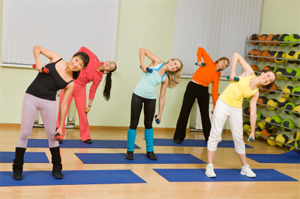November 22, 2010
How Do We Get People To Exercise? We Make It Fun, Of Course!

By Michael D. Shaw
Up until quite recently, the notion of exercise being important to health would have been regarded as novel, if not met with outright derision. Authorities note that even during the latter part of what they call the “Industrial Period”—which lasted to the end of World War II—most people were still getting sufficient exercise, based on the demands of their daily life.
This was to change with the rapid spread of technology and labor-saving devices, that would affect nearly all forms of human activity, including jobs that were once much more physically demanding. In late 1962, Life magazine spoke of The Flabby American, and during his first year in office, JFK formed the President’s Council on Physical Fitness. He appealed to Americans to get in shape as a matter of patriotic duty.
It is hardly earth-shattering to point out that 47 years later, many of us are a good deal fatter and less fit than our Kennedy-era predecessors.
Motivating people to exercise usually involves some sort of educational process. “If folks only knew the benefits, they would surely begin an exercise program,” is the common, if often ineffectual refrain. Yet, human nature being what it is, we seldom do anything unpleasant unless we get paid for it, or the consequences of not doing it are even more unpleasant, if not immediately life-threatening.
Thus, the first, and most obvious way to get people to exercise, is to make it enjoyable.
For some, this means a competitive sports league. However, this requires proficiency in a sport, and would likely exclude the very individuals most in need of an exercise program.
For many, the answer to getting fit is joining a health club. According to the International Health, Racquet & Sportsclub Association, nearly 40 million Americans are members. Once a person joins a club, he has the option of engaging in group or individual exercise programs. I asked Carol Himes—general manager of Worldgate Sport & Health in Herndon, VA—to elaborate.
In our experience, 20 percent of members will only participate in group exercise, while a high percentage of all members participate in some group exercise classes. Many factors come into play. Some are reluctant to venture onto the fitness floor on their own, some like the social component of group programs, while others enjoy the friendly competition that exists within the group. And, within group exercise, there are, of course, many different specialized areas.
One of these specialized areas is exercise dance aerobics and a big factor within this space is Zumba®, a program that incorporates Latin music and rhythms into interval training sessions designed to sculpt your body while burning fat. Introduced in the mid-1990s by trainer Beto Perez, Zumba is currently taught at more than 90,000 locations in 110 countries.
I talked to Katie Hughes, a Ph.D. chemist, Zumba instructor, and entrepreneur…
In 2007, I launched a series of Zumba classes at the Princeton University gym. Although, at that point, I had been teaching various group fitness classes for five years, Zumba classes presented a different set of challenges that I had previously not faced. The first challenge was all the hip movement that was involved, the second was what shoes to wear.
Even though she and her students liked wearing their cross-training shoes for the support they offered, such shoes are not designed to allow one to spin or pivot in the ball of the foot—essential in Zumba.
Katie began to experiment with bands that would cover up some or all of the treads on the ball of the foot of her cross-trainers, and finally came up with Slip-On Dancers, a patent-pending, easy-to-use and inexpensive product, made in America.
While some of us are strongly self-motivated and are resourceful enough to achieve sufficient exercise outside of a health club, clearly, these facilities are at the heart of the fitness movement. And, the constantly expanding world of group exercise classes makes it fun for millions. It looks like the answer to The Flabby American is good old free enterprise.

